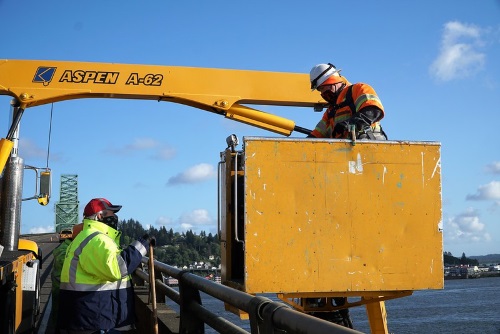The American Association of State Highway and Transportation Officials urged in a July 20 letter to Congressional leadership that state departments of transportation across the country need an “immediate infusion” of at least $37 billion to prevent disruptions to planned transportation projects, keep workers employed, and enable the nation’s mobility network to fully support economic recovery from the COVID-19 pandemic.
[Above photo by the Oregon DOT.]
While AASHTO said the near-term financial need for state DOTs remain the same in fiscal year 2020 – roughly $16 billion – data compiled over the last three months indicates state transportation revenues will not fall quite as much over the longer-term as initially projected at the beginning of the COVID-19 outbreak.

“This change in estimated loss is mainly due to a less severe outlook for FY 2021 from our members compared to earlier this year,” noted Patrick McKenna – director of the Missouri Department of Transportation and AASHTO’s 2019-2020 president – and Jim Tymon, the group’s executive director, in the letter.
“That being said, the recovery period is now expected to be longer than originally anticipated,” they added, pointing out that the requested $37 billion in emergency funding “will prevent further disruptions to planned transportation projects and allow state DOT employees and transportation construction workers essential to planning and delivering these projects to remain on the job.”

However, overall state transportation revenue losses will still be extremely steep over the next five years, McKenna and Tymon emphasized.
“With millions of Americans following ‘stay-at-home’ orders, many state DOTs are facing severe losses in revenues, including dedicated user fee revenues on which state transportation programs heavily rely,” they said.
“Projections continue to show decreases in state motor fuel tax and toll receipts as nationwide vehicle traffic reduction bottomed out at about 50 percent during the height of the pandemic,” McKenna and Tymon added. “As a result, the ability of state DOTs to carry out their core functions, including capital construction programs, is threatened.”

AASHTO and 39 other transportation organizations also made a similar appeal to Congressional leaders in a separate letter on July 20.
“The need for federal funding for state DOTs remains urgent,” that coalition of groups said in their letter. “[That] funding will also preserve the core capabilities of state DOTs that are critical to implement a robust, bipartisan surface transportation reauthorization bill, which can serve as a platform for national economic recovery and growth.”
For example, on July 16, the Wyoming Department of Transportation announced that it would delay 11 construction projects and review local transportation programs due to “long- and short-term funding issues” caused by reductions in fuel tax revenues, petroleum market revenues, and other fees – with the COVID-19 pandemic creating “additional” budgetary impact.

According to K. Luke Reiner, Wyoming DOT’s director, that “delay” will reallocate about $436 million over the next six years from new capacity improvement efforts to asset maintenance projects.
“We are operating in unprecedented times exacerbated by the coronavirus pandemic and we need to look at every avenue to save money,” he said in a statement. “WYDOT’s state and federal funding streams also have not kept pace with the needs of the state-owned transportation system for maintenance, construction and improvements or even inflation. The impact of the coronavirus pandemic has further compounded those issues.”
The Oregon Department of Transportation also reported similar fiscal issues resulting from the COVID-19 pandemic, noting that its July revenue forecast now estimates the Oregon’s State Highway Fund will lose $170 million in revenue for 2020 and 2021.

“Because the state’s projected economic recovery will extend into 2024, the impact will expand as well, increasing to a total of about $250 million in lost revenue from 2020 to 2024 when compared to the October 2019 forecast,” explained Travis Brouwer, the Oregon DOT’s assistant director, in a July 13 statement.
“This amount is split between cities, counties and ODOT, so the impact will be felt statewide,” he added. “Certainly we will need to review the plans, projects, and programs we had in place with the previous budget to determine where we need to make adjustments. We’ll be working on specifics in the next few months.”
 Top Stories
Top Stories


